Training for the CrossFit Games: Part 1
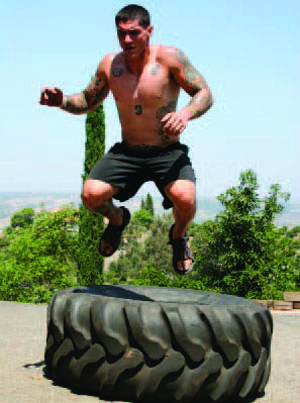
My best client of all time (by best I mean does what I tell him to, works his ass off, doesn’t complain, and shuts up when he’s supposed to be training) let me know he wants to train for next year’s CrossFit Games. This is something Robb Wolf and I had just been discussing recently, so I was eager to use Leo as a guinea pig.
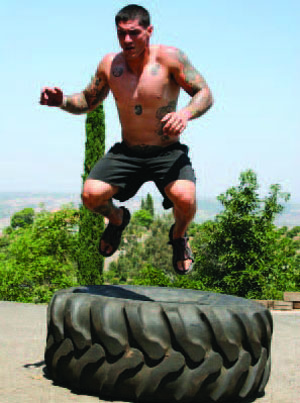
Background
Leo is a former Marine, age 31, about 5’ 9” and 175 lbs. He first came to me about two years ago with a solid training background and a good fitness base. At the time, he was preparing primarily for Muy Thai fighting, so our training was geared specifically for that. I used a mix of basic strength training on a simple progression mixed with relatively brief CrossFit-style metabolic work.
Recently he has taken a break from fighting and some time off of training, and his bodyweight was up to about 180 lbs, somewhat heavier than what he feels is best for him, closer to 160, although I’d rather keep him between 170-175. His strength in general is still good, although overhead strength is a clear weakness, compounded by some shoulder problems. His Olympic lifting experience is limited, with most of the work in the past being limited to hang power snatches and cleans and push jerks. Metabolically, he is in decent shape, although obviously below the level we had reached in his previous training.
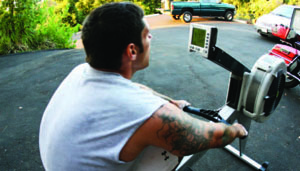
Predicting the Games Events
The greatest problem in preparing for the CrossFit Games is that we don’t know what exactly the events will entail. Preparation has to cover a wide spectrum of possibilities, and this dilutes progress in any specific area. That said, we can make some assumptions to help guide the training.
The first Games was comprised of a CF Total, a distance run, and a medium-long duration CrossFit metCon. The number of athletes in attendance was small, and even then, this format proved too cumbersome. The second Games saw a complete revision of the approach—two short-medium duration CrossFit metCons and a short hill run on the first day and one final short duration metCon on the second day. All workouts were capped at 15 minutes, and many athletes finished in less than 5 minutes. This was obviously a much more practical format and was able to accommodate far more athletes.
We can safely assume that next year will involve a similar format, at least in terms of workout durations—it’s extremely unlikely any workout will exceed the fifteen-minute mark. We can also assume that for simple logistics reasons that the chosen exercises will rely on minimal and basic equipment such as barbells and pull-up bars. It’s unlikely we’ll see rings, kettlebells, rowers and the like, although entirely possible. This brevity and simplicity suggests each workout will involve few exercises, relatively heavy loading and relatively low rep numbers, as we saw this year. Finally, exercises will need to be fairly simple for reasons of judging acceptable execution.
Of course, this is all speculation and because CrossFit is by design unpredictable, there’s always a chance we could be, come game day, totally fucked.
Having said that, I’m confident enough in my predictions to commit to the resulting programming, and even if those predictions are off to some degree, Leo will still be well enough prepared in general to make a good showing.
Training Environment
For his weightlifting and strength training, Leo couldn’t find a better training environment than Mike’s Gym—he’s surrounded by competitive weightlifters and coaches. Unfortunately, he’s at a decided disadvantage in terms of CrossFit training. Without any other CrossFitters to train with, compete against and even commiserate with, he has to rely on my and Mike Burgener’s yelling and his own discipline for motivation. He’s removed from a key element of CrossFit and will certainly need to work harder than many to maintain his motivation.
Program Design
Because we’re a year away from the event, we have a lot of liberty in programming at this point. That is, we can spend a lot of time progressing in specific areas instead of having to try to cram everything in together at once and hope for the best. This means we can commit to a long initial phase of basic strength work and frequent Olympic lifting to create a solid base to work from.
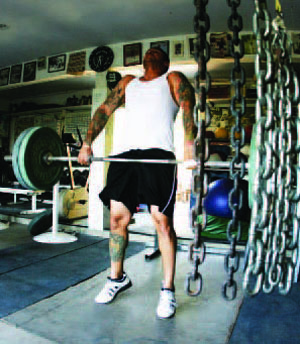
For the first three weeks, we used the following program, starting the strength and weightlifting exercises comfortably within Leo’s abilities and attempting to add weight to all exercises each week. Much of the weightlifting work was focused on technique and rarely did we stick to the prescriptions completely; instead I decided based on what I saw each day what technique drills were needed and went from there.
Leo’s shoulder problems became evident during this time—the overhead pressing in particular was painful enough that we cut out pressing altogether the final week and were conservative with the other overhead work.
On all training days, Leo performed 2-3 ab exercises at the end of each workout. These were rotated fairly randomly to allow us to cover all the bases.
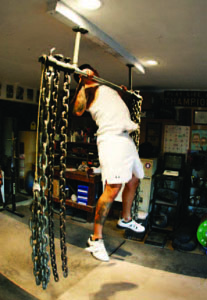
The CrossFit workouts were modulated throughout the week to minimize their impact on Leo’s recovery for the strength work, which is our current priority. These workouts were kept in the 7-10 minute range and were relatively easy on the legs. On Thursdays, we used a classic CrossFit workout such as Helen, Jackie, or Cindy (briefer) as both training and a diagnostic tool to continually gauge the state of Leo’s metabolic conditioning. These workouts contain pull-ups at least twice weekly.
Weeks 1-3
Monday
Snatch – 5 x 2
Back squat – 5 x 5
Press – 5 x 5
Tuesday
Power snatch – 3 x 2
Power clean & jerk – 3 x 2
Medium CrossFit
Wednesday
Clean & jerk – 5 x 2
Deadlift – 3 x 2
Front squat – 3 x 3
Thursday
Overhead squat – heavy single; 85% x 2 x 3
Push press – 5 x 5
CrossFit Girl
Friday
Rest
Saturday
Snatch – heavy single
Clean & jerk – heavy single
Back squat – heavy single
Light CrossFit
Sunday
Rest
After three weeks of the previous program, we made some adjustments according to Leo’s progress and the needs that became apparent during that time, such as temporarily reducing overhead pressing work. The following program, of which Leo has just finished his first week, is similar in structure to the previous. The squatting and deadlifting remain the same, but the pressing has been removed until we can square away Leo’s shoulders. In its place we’ve added snatch push presses—this will allow us to get at least some overhead pressing work in without aggravating the problem, and it will also help address a particular weakness of Leo’s, which is overhead strength in the snatch.
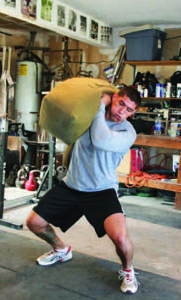
Leo has been making excellent gains in the strength exercises, so there has been no need to make changes. We’ll continue this format of squatting and deadlifting, adding weight each week, until it becomes evident he needs to back off. At that point, I’ll reevaluate and make any program changes needed.
Again, ab work will finish each training session, and we will insert kipping pull-ups into at least 2 workouts each week. At this point, I’m going to begin teaching Leo the butterfly kip and refining his default kipping style to improve his economy and allow him to compete with the leaders of the pack. We will likely insert one or two kipping pull-up sessions each week to allow more time for technique work as well as conditioning for large volumes of pull-ups. The pull-up is so clearly a staple of CrossFit training that it deserves emphasis.
Weeks 4 - ?
Monday
Muscle snatch + 2 OHS – 3 sets heavy
Power snatch + OHS – 2 + 2 x 4 sets
Back squat – 5x5
Tuesday
OHS – heavy single; 85% x 2 x 3
Snatch push press – 3 x 5
Medium CrossFit
Wednesday
Power clean – 5 x 2
Deadlift – 3 x 2
Front squat – 3 x 3
Good morning – 3 x 5
Thursday
Snatch – 6 x 1
Clean (and jerk) – 6 x 1
CrossFit Girl
Friday
Rest
Saturday
Snatch - heavy single
CJ - heavy single
Back squat – heavy single
Light CrossFit
Examples of CrossFit workouts undertake in these first weeks include:
Fran
Thrusters – 95 lbs
Pull-ups
21-15-9 reps
Helen
3 rounds of:
200 m hill sprint (instead of 400 m flat)
21 KB swings – 24kg
12 pull-ups
Jackie
1000 m row
50 thrusters – 45 lbs
30 pull-ups
3 rounds of:
50 m hill sprint
10 box jumps
20 pull-ups
2 rounds of:
50 m Hill sprint
15 KB swings
20 KB chops
15 pull-ups
3 rounds of:
10 sandbag shoulder + 2 lunges
20 KB DL high pulls
10 GHD sit-ups
3 rounds of:
500 m row
15 pull-ups
20 1 arm DB snatches
What’s Next
We’ll continue with the current program as long as we can extract strength gains from it. Week to week a few things may change in regards to the weightlifting exercises such as possibly using snatch balances instead of overhead squats, doing some lifts from the hang or multiple positions, or similar modifications.
Once we’ve reached a point at which Leo has clearly maximized possible gains from this program without more dramatic changes, we’ll back him off the strength work briefly and transition him into a phase of metabolic conditioning emphasis with strength and weightlifting maintenance. We’ll check back in after another month or two with updates.

Background
Leo is a former Marine, age 31, about 5’ 9” and 175 lbs. He first came to me about two years ago with a solid training background and a good fitness base. At the time, he was preparing primarily for Muy Thai fighting, so our training was geared specifically for that. I used a mix of basic strength training on a simple progression mixed with relatively brief CrossFit-style metabolic work.
Recently he has taken a break from fighting and some time off of training, and his bodyweight was up to about 180 lbs, somewhat heavier than what he feels is best for him, closer to 160, although I’d rather keep him between 170-175. His strength in general is still good, although overhead strength is a clear weakness, compounded by some shoulder problems. His Olympic lifting experience is limited, with most of the work in the past being limited to hang power snatches and cleans and push jerks. Metabolically, he is in decent shape, although obviously below the level we had reached in his previous training.

Predicting the Games Events
The greatest problem in preparing for the CrossFit Games is that we don’t know what exactly the events will entail. Preparation has to cover a wide spectrum of possibilities, and this dilutes progress in any specific area. That said, we can make some assumptions to help guide the training.
The first Games was comprised of a CF Total, a distance run, and a medium-long duration CrossFit metCon. The number of athletes in attendance was small, and even then, this format proved too cumbersome. The second Games saw a complete revision of the approach—two short-medium duration CrossFit metCons and a short hill run on the first day and one final short duration metCon on the second day. All workouts were capped at 15 minutes, and many athletes finished in less than 5 minutes. This was obviously a much more practical format and was able to accommodate far more athletes.
We can safely assume that next year will involve a similar format, at least in terms of workout durations—it’s extremely unlikely any workout will exceed the fifteen-minute mark. We can also assume that for simple logistics reasons that the chosen exercises will rely on minimal and basic equipment such as barbells and pull-up bars. It’s unlikely we’ll see rings, kettlebells, rowers and the like, although entirely possible. This brevity and simplicity suggests each workout will involve few exercises, relatively heavy loading and relatively low rep numbers, as we saw this year. Finally, exercises will need to be fairly simple for reasons of judging acceptable execution.
Of course, this is all speculation and because CrossFit is by design unpredictable, there’s always a chance we could be, come game day, totally fucked.
Having said that, I’m confident enough in my predictions to commit to the resulting programming, and even if those predictions are off to some degree, Leo will still be well enough prepared in general to make a good showing.
Training Environment
For his weightlifting and strength training, Leo couldn’t find a better training environment than Mike’s Gym—he’s surrounded by competitive weightlifters and coaches. Unfortunately, he’s at a decided disadvantage in terms of CrossFit training. Without any other CrossFitters to train with, compete against and even commiserate with, he has to rely on my and Mike Burgener’s yelling and his own discipline for motivation. He’s removed from a key element of CrossFit and will certainly need to work harder than many to maintain his motivation.
Program Design
Because we’re a year away from the event, we have a lot of liberty in programming at this point. That is, we can spend a lot of time progressing in specific areas instead of having to try to cram everything in together at once and hope for the best. This means we can commit to a long initial phase of basic strength work and frequent Olympic lifting to create a solid base to work from.

For the first three weeks, we used the following program, starting the strength and weightlifting exercises comfortably within Leo’s abilities and attempting to add weight to all exercises each week. Much of the weightlifting work was focused on technique and rarely did we stick to the prescriptions completely; instead I decided based on what I saw each day what technique drills were needed and went from there.
Leo’s shoulder problems became evident during this time—the overhead pressing in particular was painful enough that we cut out pressing altogether the final week and were conservative with the other overhead work.
On all training days, Leo performed 2-3 ab exercises at the end of each workout. These were rotated fairly randomly to allow us to cover all the bases.

The CrossFit workouts were modulated throughout the week to minimize their impact on Leo’s recovery for the strength work, which is our current priority. These workouts were kept in the 7-10 minute range and were relatively easy on the legs. On Thursdays, we used a classic CrossFit workout such as Helen, Jackie, or Cindy (briefer) as both training and a diagnostic tool to continually gauge the state of Leo’s metabolic conditioning. These workouts contain pull-ups at least twice weekly.
Weeks 1-3
Monday
Snatch – 5 x 2
Back squat – 5 x 5
Press – 5 x 5
Tuesday
Power snatch – 3 x 2
Power clean & jerk – 3 x 2
Medium CrossFit
Wednesday
Clean & jerk – 5 x 2
Deadlift – 3 x 2
Front squat – 3 x 3
Thursday
Overhead squat – heavy single; 85% x 2 x 3
Push press – 5 x 5
CrossFit Girl
Friday
Rest
Saturday
Snatch – heavy single
Clean & jerk – heavy single
Back squat – heavy single
Light CrossFit
Sunday
Rest
After three weeks of the previous program, we made some adjustments according to Leo’s progress and the needs that became apparent during that time, such as temporarily reducing overhead pressing work. The following program, of which Leo has just finished his first week, is similar in structure to the previous. The squatting and deadlifting remain the same, but the pressing has been removed until we can square away Leo’s shoulders. In its place we’ve added snatch push presses—this will allow us to get at least some overhead pressing work in without aggravating the problem, and it will also help address a particular weakness of Leo’s, which is overhead strength in the snatch.

Leo has been making excellent gains in the strength exercises, so there has been no need to make changes. We’ll continue this format of squatting and deadlifting, adding weight each week, until it becomes evident he needs to back off. At that point, I’ll reevaluate and make any program changes needed.
Again, ab work will finish each training session, and we will insert kipping pull-ups into at least 2 workouts each week. At this point, I’m going to begin teaching Leo the butterfly kip and refining his default kipping style to improve his economy and allow him to compete with the leaders of the pack. We will likely insert one or two kipping pull-up sessions each week to allow more time for technique work as well as conditioning for large volumes of pull-ups. The pull-up is so clearly a staple of CrossFit training that it deserves emphasis.
Weeks 4 - ?
Monday
Muscle snatch + 2 OHS – 3 sets heavy
Power snatch + OHS – 2 + 2 x 4 sets
Back squat – 5x5
Tuesday
OHS – heavy single; 85% x 2 x 3
Snatch push press – 3 x 5
Medium CrossFit
Wednesday
Power clean – 5 x 2
Deadlift – 3 x 2
Front squat – 3 x 3
Good morning – 3 x 5
Thursday
Snatch – 6 x 1
Clean (and jerk) – 6 x 1
CrossFit Girl
Friday
Rest
Saturday
Snatch - heavy single
CJ - heavy single
Back squat – heavy single
Light CrossFit
Examples of CrossFit workouts undertake in these first weeks include:
Fran
Thrusters – 95 lbs
Pull-ups
21-15-9 reps
Helen
3 rounds of:
200 m hill sprint (instead of 400 m flat)
21 KB swings – 24kg
12 pull-ups
Jackie
1000 m row
50 thrusters – 45 lbs
30 pull-ups
3 rounds of:
50 m hill sprint
10 box jumps
20 pull-ups
2 rounds of:
50 m Hill sprint
15 KB swings
20 KB chops
15 pull-ups
3 rounds of:
10 sandbag shoulder + 2 lunges
20 KB DL high pulls
10 GHD sit-ups
3 rounds of:
500 m row
15 pull-ups
20 1 arm DB snatches
What’s Next
We’ll continue with the current program as long as we can extract strength gains from it. Week to week a few things may change in regards to the weightlifting exercises such as possibly using snatch balances instead of overhead squats, doing some lifts from the hang or multiple positions, or similar modifications.
Once we’ve reached a point at which Leo has clearly maximized possible gains from this program without more dramatic changes, we’ll back him off the strength work briefly and transition him into a phase of metabolic conditioning emphasis with strength and weightlifting maintenance. We’ll check back in after another month or two with updates.
| Greg Everett is the owner of Catalyst Athletics, publisher of The Performance Menu Journal and author of Olympic Weightlifting: A Complete Guide for Athletes & Coaches, Olympic Weightlifting for Sports, and The Portable Greg Everett, and is the writer, director, producer, editor, etc of the independent documentary American Weightlifting. Follow him on Facebook here. |
Search Articles
Article Categories
Sort by Author
Sort by Issue & Date
Article Categories
Sort by Author
Sort by Issue & Date

